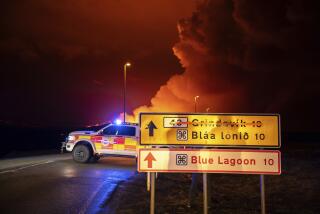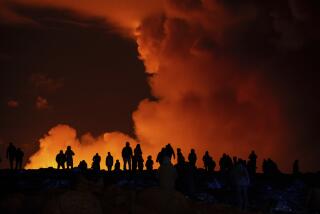Roam Iceland’s countryside and savor the sveit life
I’M lying slack-jawed on a plank of hot wood, supine and defenseless over a gaping hole in the Earth’s crust. Magma flows about a mile below me; above me, a drop of water condenses on the ceiling of a dimly illuminated steam room in the Myvatn Nature Baths, the lesser-known cousin to Iceland’s iconic Blue Lagoon, that geothermal destination outside of Reykjavik often touted for its health benefits.
Myvatn, near the town of Akureyri (riddled with consonants, Icelandic words are not easy to tackle, but saying “mee-VAHT” and “ah-KOO-ray-ree” will get you by), is more or less on top of the ever-growing chasm between the North American and Eurasian plates. In the ‘70s and ‘80s, this region fielded nine eruptions from a nearby series of volcanic fissures. Locals had to put their tap water in the fridge to cool.
But on this winter’s day, I’m left undisturbed to enjoy the low-lying fruits of plate tectonics: hiking on a black crust of a lava field, taking the womblike geothermal waters and breathing these hot, sloth-inducing vapors. Across the steam room, my friend flops onto her stomach in the mist, and I watch the drop of condensation slowly muster its strength. It falls.
That was winter 2006, during my five-year stint as an on-and-off-again resident in Iceland, first as a student of Icelandic and, more recently, as an editor of the magazine Iceland Review. A visiting friend and I, two Angelenos, had hit the road after work in my four-wheel drive and headed north to escape the chaos of a January snowstorm in Reykjavik. By midnight, we faced the dark, empty expanse of the Greenland Sea along Iceland’s northern coast.
Iceland gets more yearly visitors than it has residents (a little more than 300,000), and nearly all of these tourists make Reykjavik and environs their primary destination. I’ve watched too many of them fly all the way to the middle of the North Atlantic, hit the bars and spend the rest of their vacation hung over. So I always gave my guests the same line: If you’re on the island for a long weekend, you have a choice. You can explore Reykjavik’s amusing but over-hyped night life and suffer -- and I do mean suffer -- the physical and financial consequences, or you can escape the grip of the $11 pint and explore.
Akureyri, Iceland’s second-largest city at 16,700, is a base for another kind of weekend. Here the days revolve more around sheep than stocks, and beater Ford Broncos are more common than Reykjavik’s flashy fleet of SUVs. People in Reykjavik still call northern Iceland the sveit, or countryside, and it remains an idyllic escape from the capital’s increasing pressures -- and increasing ennui for tourists.
Up north, you might find yourself standing in an empty heath with only a few blank-faced sheep and a looming volcanic crater to keep you company. Or you might find yourself treated to a good dose of Icelandic country hospitality from a local who still has the patience to show a stranger around this strange land.
FREEWHEELING ROAD TRIP
Depending on the weather, the drive to Akureyri is about five hours. Though buses regularly shuttle between Reykjavik and Akureyri, part of the trip’s charm is being able to pull over and fill up a water bottle in a frigid mountain stream (perfectly safe) or stop in at a gas station for a lamb hot dog with remoulade and fried onions (of questionable safety but delicious).
Before I bought my own banged-up SUV, I routinely rented cars to escape. Like everything else in Iceland, rental prices and gas are killers, but the freedom is worth it and -- perhaps because they’re charging a premium -- rental companies are strangely relaxed when a vehicle is returned caked with mud.
Every three or four months, I found myself heading north either in the winter with January’s roving green bands of northern lights swaying above me or in the summer when the wind-driven rain pelts the countryside. Akureyri leaps out after a turn in the road: a hub of lights and colorful houses built into the hills.
Complete with its own international airport (flights from Copenhagen), the town is surprisingly cosmopolitan in its isolation: sleek cafes, a selection of bars entirely out of proportion to the population and boutiques that hawk designer jeans and candles to passersby on the cobblestone downtown streets.
There are plenty of options here to stash your gear while you venture out from town to explore by day. I’ve stayed in the centrally located, upmarket Hotel Kea, where Icelanders gather after dinner for whiskey and cigars in a bar packed with leather chairs, and in a wooden prefab summer cabin outside of town that came with a hot tub that we had to pay to fill up with water. Both had their charms.
One of the closest and best hops outside the city is Lake Myvatn, an hour’s drive southeast of Akureyri along Route 1. Myvatn means “midges,” and the lake, about three times the size of California’s Big Bear Lake, has the dubious distinctions of producing a serious infestation of summer flies and naturally occurring globular balls of algae. The phenomena are part of the lake’s rich ecosystem that draws migratory birds to settle and build nests on the lake every summer.
I visited the lake one day in August, and while looking for a spot to buy some locally smoked fish, I met a members of a family that sold and packaged lake trout in the yard of their waterfront home. They owned one of the lake’s small lava islands, and because travel in Iceland’s countryside is almost always defined by unexpected invitations to do unexpected things, I was soon asked to tag along on an island egg hunt.
A light rain fell on us as we navigated Myvatn’s murky waters in a small, open motorboat, and the lake’s intolerable flies rushed into our nostrils for cover. Once we scrambled ashore, most of the party lighted cigarettes to keep the insects at bay, but the bugs were a persistent atmosphere all their own, hovering around our eyes and mouths as we threaded our way through waist-high stalks of summer angelica, that celery-like herb.
We found a few eggs, mostly ferreted out by Sigfus, a gangly middle-aged villager who knew where to find the nests deep in the undergrowth. Sigfus, who grew up on the lake and runs a guesthouse here, was showing his teenage son the ropes, peering beneath the root of the angelicas’ sunburst blooms to pluck treasure from dark, secret places.
Sigfus spoke slowly and carefully, explaining the lake’s customs and extolling its many virtues. Angelica, he said, was being studied by a scientist in Reykjavik as a cure for cancer. “Very, very healthy,” Sigfus said of the plant, rubbing its greenish flower between his fingers. “In the future, it will be expensive.”
Uprooting one of the herb’s tall stalks, he demonstrated a ritual of the hunt, snapping the stalk in half to reveal its hollow core. He cracked an egg into the stalk, tipped it to his lips, and tossed the raw protein back like an oyster shooter.
LIKE PART OF THE FAMILY
If you look at a map of Iceland, you will see Akureyri sitting almost dead center between east and west, tucked in a fiord on the north shore. Myvatn, Sigfus’ hometown, is a short jog east. If you follow the road (yes, the only road) to the west, however, you will find the last inhabited place on the northwest coast, the farming community of Arneshreppur.
The first time I drove up the one-lane dirt road to Arneshreppur, I had rented a small car with a junky radio that only got one station. Johnny Cash sang “Ring of Fire” over the snapping static as my friend Lissa and I peered down the side of steep cliffs, notably lacking guardrails, at the unforgiving North Atlantic.
We were headed to Hotel Djupavik, a little less than 50 miles north of anything qualifying as a town and one of the few places to stay on this remote stretch. The hotel itself, a former dormitory next door to an abandoned herring factory, sits deep in the crook of a narrow fiord, where a slowly sinking fishing trawler and the concrete hulk of the defunct factory are stalwart reminders of a long-lost local economy.
Lissa and I stepped into the dark, wood-floored dining room of the hotel after sunset, where Eva Sigurbjornsdottir, one-half of the inn’s husband-and-wife team, cheerfully served us burritos. After dinner, we settled into a communal couch upstairs to watch the 1999 film “Election” on an Icelandic station. In time, Eva’s entire family, grandchildren and all, in jammies and robes, walked up the creaky wood stairs and joined us around the television, the blue glow of the TV soon flickering on their faces.
You don’t have to drive quite as deeply into Iceland’s rural isolation as Arneshreppur to get a glimpse of how things are done in the sveit. In late summer and early autumn, one of Iceland’s most public social events erupts throughout the countryside -- the fall sheep and horse round-up -- when families band together to collect their animals that have been wandering the grasslands all summer.
On a September morning, I pulled into a gravelly parking lot in Skagafjordur, an inland farming area an hour west of Akureyri. A thin layer of snow dusted the rolling heath behind me. Farmers’ wives, daughters and sisters were setting out plates of rhubarb cake and smoked lamb sandwiches to raise money for the local farming association.
After hitting the spread, I wandered to the side of the dirt road, picking the last of summer’s wild blueberries and watched the first wave of sheep thunder toward the human crowd. Ewes, rams and lambs charged forward, leaping and crying, and some very happy sheep dogs ran alongside to keep strays from escaping the herd.
Once corralled in a low concrete ring, the sheep ran counterclockwise in a chaotic current of wool and panic. Young farmers jumped into the fray, straddling the animals and checking their ear tags. Some tourists joined the action: One woman leaped astride a ram and threw her head back, laughing, as she tried to get control over the animal by its horns. After being sorted out and returned to their farms, the lambs would be driven to the abattoir -- the end of summer and beginning of leg-of-lamb season.
I don’t remember much about the trek back to Reykjavik that brisk day, apart from stopping at a gas station for a greasy burger and a spectacular coconut-dipped marshmallow confection called a kokosbullar. The sugar dose might have wiped out my recollection of those hours.
Leaving behind the mountain pass that separates the north from the greater Reykjavik area, the two-lane highway cuts through a mossy lava field, traverses the waters of a narrow fiord, then descends into a long tunnel that empties into Reykjavik. The city’s suburban sprawl may not be the most attractive sight that Iceland has to offer, but I’m sure I had the same feeling that I always did coming back from the sveit: At least I knew where to go for a cold tall pint.
More to Read
Sign up for The Wild
We’ll help you find the best places to hike, bike and run, as well as the perfect silent spots for meditation and yoga.
You may occasionally receive promotional content from the Los Angeles Times.






